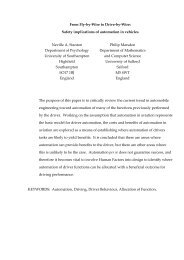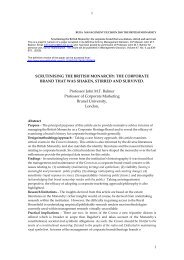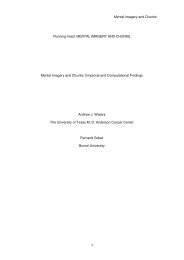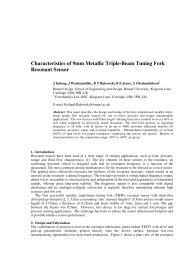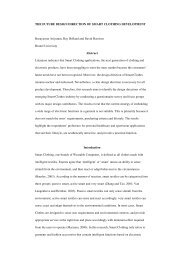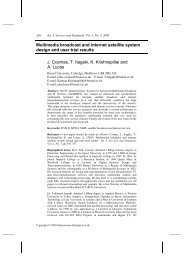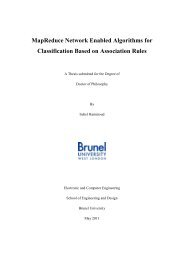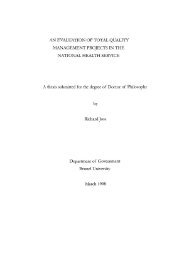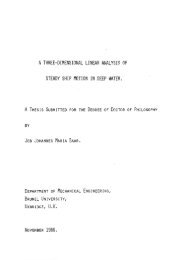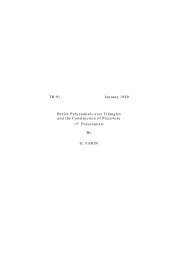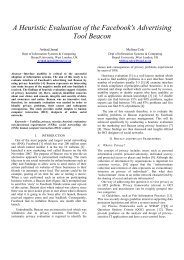Chapter 1 - Brunel University
Chapter 1 - Brunel University
Chapter 1 - Brunel University
You also want an ePaper? Increase the reach of your titles
YUMPU automatically turns print PDFs into web optimized ePapers that Google loves.
Abstract, Acknowledgement, Table of Content and Abbreviation<br />
3.1.7.1 Organisational Factors Influencing E-Government Implementation ................................ 57<br />
Organisational Structure ................................................................................................. 57<br />
Power Distribution .......................................................................................................... 57<br />
Information System Strategy Alignment........................................................................... 57<br />
Prioritisation of Deliverables .......................................................................................... 58<br />
Future Needs of the Organisation ................................................................................... 58<br />
Organisational Culture.................................................................................................... 58<br />
Training ........................................................................................................................... 59<br />
3.1.7.2 Technical Themes Influencing E-government Implementation ....................................... 59<br />
Information Technology (IT) Standards: ......................................................................... 59<br />
Security and Privacy ........................................................................................................ 60<br />
System Integration ........................................................................................................... 60<br />
E-government Portal and Access ..................................................................................... 61<br />
3.1.7.3 Social Themes Influencing E-government Implementation ............................................. 61<br />
Citizen-Centric Focus ...................................................................................................... 61<br />
Awareness ........................................................................................................................ 62<br />
The Digital Divide ........................................................................................................... 62<br />
3.1.7.4 Political Themes Influencing E-government Implementation .......................................... 63<br />
Government Support ........................................................................................................ 63<br />
Funding ........................................................................................................................... 63<br />
Leadership ....................................................................................................................... 63<br />
Legislation and Legal ...................................................................................................... 64<br />
3.1.8 A Conceptual Model for E-government Implementation in Qatar ................................... 66<br />
3.2 E-government Adoption: The Citizens‘ Perspective ................................................................ 69<br />
3.2.1 Technology Adoption Theories ........................................................................................ 69<br />
3.2.1.1 Theory of Reasoned Action (TRA) .................................................................................. 70<br />
3.2.1.2 Theory of Planned Behaviour (TPB) ................................................................................ 70<br />
3.2.1.3 Innovation Diffusion Theory (IDT) ................................................................................. 70<br />
3.2.1.4 Technology Acceptance Model (TAM) ........................................................................... 71<br />
3.2.1.5 Unified Theory of Acceptance and Use of Technology (UTAUT) .................................. 71<br />
3.2.2 Research Model and Hypotheses for E-government Adoption in Qatar .......................... 73<br />
3.2.2.1 Performance Expectancy .................................................................................................. 75<br />
3.2.2.2 Effort Expectancy ............................................................................................................ 75<br />
3.2.2.3 Social Influence................................................................................................................ 76<br />
3.2.2.4 Facilitating Conditions ..................................................................................................... 76<br />
3.2.2.5 Behavioural Intention ....................................................................................................... 77<br />
3.2.2.6 Gender .............................................................................................................................. 78<br />
3.2.2.7 Age ................................................................................................................................... 78<br />
3.2.2.8 Education Level ............................................................................................................... 79<br />
3.3 <strong>Chapter</strong> Summary ..................................................................................................................... 83<br />
<strong>Chapter</strong> 4: Research Methodology ...................................................................................... 84<br />
4.1 Introduction .............................................................................................................................. 84<br />
4.2 Selecting an Appropriate Research Approach .......................................................................... 85<br />
4.3 Use of Qualitative Research vs Quantitative Research Approach ............................................ 87<br />
4.4 Use of Case Study Method ....................................................................................................... 90<br />
4.4.1 Single Versus Multiple Case Studies ............................................................................... 90<br />
4.4.2 Case Study Data Analysis ................................................................................................ 91<br />
4.5 Use of Survey Method.............................................................................................................. 94<br />
4.6 Use of Multi-Method Research: Combining Quantitative and Qualitative Research ............... 96<br />
4.7 The Strategy Adopted for this Research ................................................................................... 97<br />
4.7.1 Phase 1: Qualitative Strategy: Using Case Study Method ................................................ 98<br />
Shafi Al-Shafi vii



